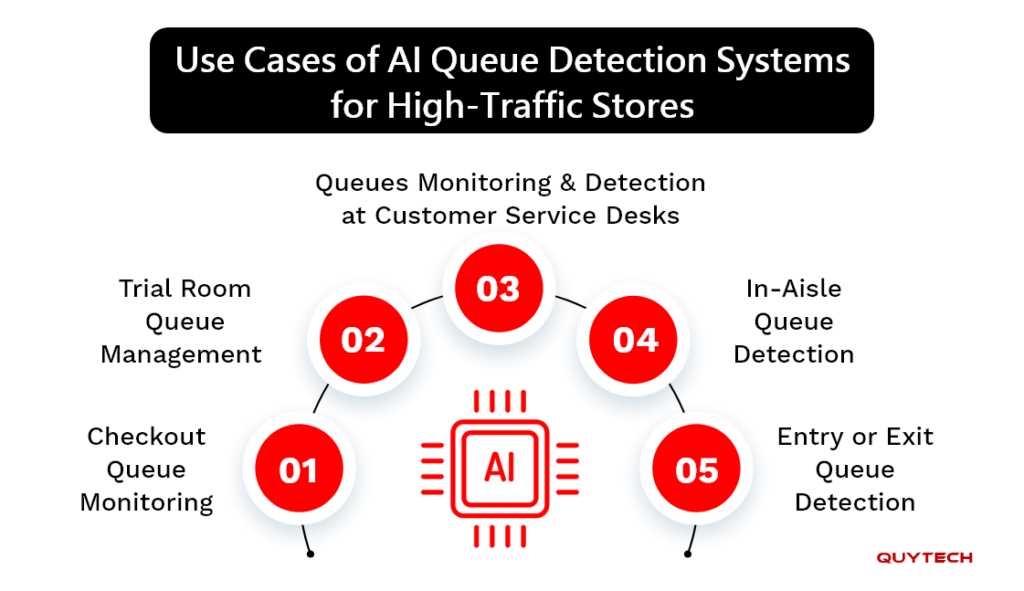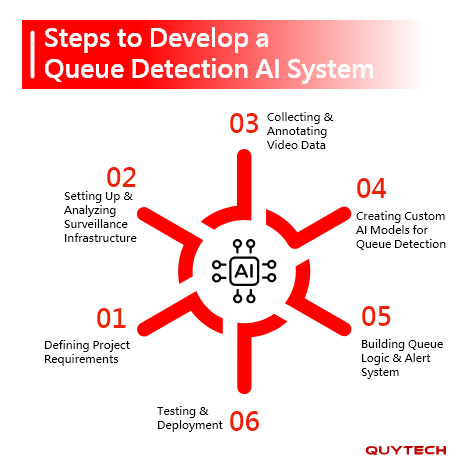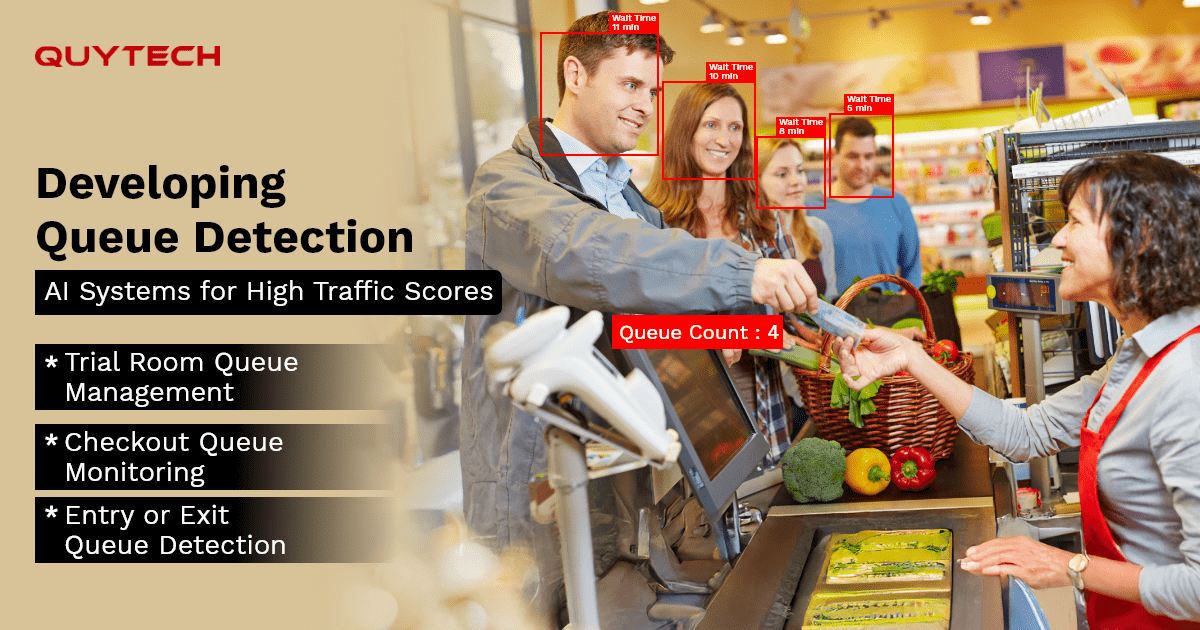An online study highlights that nearly 73% of customers will leave their cart if the checkout process takes longer than the usual time. The same percentage of people would even love to shop from a competitor where they perceive a shorter queue time.
While the scenario clearly spotlights the significance of customer time and satisfaction, it also creates a dire need for high traffic stores to have an efficient queue detection system for better customer management at checkouts, entry/exits, trial rooms, aisles, and customer support desks.
Queue detection systems, mainly those powered by AI, can be seamlessly integrated with CCTV cameras and surveillance systems to process the captured footage in real-time to detect long queues and trigger an alert about similar incidents. A queue Detection AI system is a game changer for high traffic stores.
But how to develop these systems? How do they work? What benefits does an AI-powered queue detection system offer? What technologies facilitate the amazing functioning of such systems? This blog provides answers to all these questions. So, what wait? Let’s start!
What is a Queue Detection AI System?
It’s an intelligent system that leverages technologies like artificial intelligence, machine learning, and computer vision to monitor and detect queues in real-time in stores with high foot traffic. The system works together with CCTV or IP cameras installed inside or outside the stores to identify individuals or groups of people forming a queue.
The system can also track the behavior of people waiting in a queue and even measure metrics like wait time, customer flow, and queue length.
Learn More: Suspicious Behavior Detection Systems: Complete Development Guide
How does an AI-Powered Queue Detection System Work
When integrated with the surveillance or monitoring system, an AI-based queue detection system follows a series of steps to capture and process video feed or footage and then provide real-time insights and raise alerts.
#1 Analyzing Live Video Streams
The first step includes analyzing live video feeds that in-store CCTV cameras (especially those placed at critical places where the chances of queue formation are high) collect in real-time. The AI models and detection algorithms equipped in the queue detection systems meticulously detect individuals and unusual queue formations, considering spatial proximity and the time that an individual stays at one place in the queue.
Read More: AI-Enabled Video Analysis: Everything You Need to Know
#2 Triggering Alerts
As the detection system finds unusual queue formation or people standing in one place for more than the defined threshold, it triggers an immediate alert for security to intervene and ensure the safety of people.
#3 Real-Time Actions and Insights
Apart from real-time alerts for immediate actions or responses, the queue detection AI system also generates insights that high-traffic stores can utilize to optimize store layout, schedule staff, and maintain customer flow.
Why implementing an AI-based Queue Detection System is the Need of the Hour for High-Traffic Stores
Having a queue detection system can transform how you manage footfall in your busy store. It is one of the critical metrics for customers to choose your store over others. Here are a few other reasons that make it a necessity to upgrade your surveillance system by integrating it with an artificial intelligence-powered queue detection and management system.
#1 Customers’ Expectations Have Changed
Speed, convenience, and real-time service are the three things that a customer expects from any retailer. Meeting these three requirements (of course, along with quality products and services) makes you earn their loyalty. Making them wait in long queues at checkout, trial rooms, and other places in the store means not being able to deliver them a great experience.
An AI queue detection system can monitor the store in real-time to avoid congestion and ensure a quick response when required.
#2 Customer Dissatisfaction May Result in Revenue Loss
Customers feel dissatisfied when their shopping experience is not seamless and takes longer than expected. Long queues, no matter if during checkout, entrance/exit, customer service desk, or any other area of the store, may make the customer leave the store and shop somewhere else. This may result in a significant loss of revenue. According to a report, nearly 77% of customers feel dissatisfied if they have to wait in lengthy queues.
In such a situation, the AI queue detection software can immediately raise an alert to make the store managers deploy additional teams to clear congestion.
#3 Compliance with Safety and Hygiene Norms is Non-Negotiable
Crowd control and queue management are not just about providing great customer service; it’s about safety as well. Managing both cannot be achieved with traditional monitoring systems, which don’t provide any real-time insights.
An intelligent queue detection system can do this by processing the captured video streams in real-time. It can provide real-time insights for informed decision-making, right when it is needed.
#4 Bringing Business Intelligence is a Must to Thrive
Apart from detecting queues and congestion in busy stores, these systems can also provide actionable insights to enable stores to manage their workforce effectively. They can get insights on peak hours, customer dwell times, and other critical metrics to improve store layouts, marketing efforts, and customer flow.
You may like to read: AI-Powered Video Analytics for Public Sector
Use Cases of AI Queue Detection Systems for High-Traffic Stores
High traffic stores, like supermarkets, department stores, electronics outlets, and big-box retailers, often find it difficult to deal with sudden foot traffic or customer footfall. But managing queues is crucial to delivering customers a smooth shopping experience. Therefore, if you want to build a queue detection AI system, you should know how such a system can transform queue management at your store.

#1 Checkout Queue Monitoring
Stores with high footfall can implement an AI-based queue monitoring system at checkout counters to continuously monitor queue buildup. The system uses computer vision to detect and track people in real-time and edge AI to process video data right where it is generated, i.e., the CCTV camera.
It also relies on threshold-based alerts to immediately raise an alert if the queue length exceeds a predefined threshold. The system also has an analytics dashboard, using which store managers or security personnel can check peak checkout times, staff efficiency, and the average time taken by an individual to check out.
#2 Trial Room Queue Management
This type of queue management is required, particularly in fashion and apparel stores. Long queues outside fitting or changing rooms may result in customer frustration; they may even skip trying and ultimately, buying that particular product.
An AI queue detection system can quickly detect the line and alert managers to take the required action. The system relies on people counting algorithms to measure foot traffic and waiting times, heatmap analysis to identify congestion, spatial positioning for queue length detection, and real-time alerts to notify the staff.
#3 Queues Monitoring and Detection at Customer Service Desks
Customer service desks are the counters where customers contact to get resolutions to their queries. They could get congested during peak hours or a few days after any particular sale ends to manage post-sale returns. A queue detection system powered by AI can be a savior for the staff taking care of customers’ queries.
The system can identify delays using AI-based dwell time calculation, measure emotional cues or expressions with facial detection, predict busy hours with queue pattern recognition, and can even be integrated with Point of Sale systems to ensure intelligent resource planning.
#4 In-Aisle Queue Detection
Particular sections or zones, including electronics or sale items, in a high-traffic store may experience more than usual footfall and dwell time. AI-powered queue management software can detect zone-based crowding to detect queues in specific zones and prevent in-aisle congestion that may impact customer experience.
The software immediately flags unusual wait times with anomaly detection, observes customer flow and stop points with motion tracking, and sends instant alerts to store managers to deploy more personnel to manage queues.
#5 Entry or Exit Queue Detection
A high-traffic or busy store may experience more than usual crowds at its entrance or exits, mainly during holidays, flash sales, or events. This may lead to queue buildup and unnecessary congestion. With manual oversight, it is difficult to keep a tab on the entrance/exit points.
However, an AI queue detection system can do this without manual intervention. It forecasts peak entry and exit times with time-series analysis, does real-time occupancy monitoring, and ensures adherence to safety norms with real-time compliance alerts.
You might also be interested in: AI Video Analytics in Retail: CCTV Security Solution
Steps to Develop a Queue Detection AI System
Please note that building an AI queue detection system from cradle to grave requires an in-depth expertise in artificial intelligence, machine learning, computer vision, video analytics API development, and other technologies. It also requires you to have a full-fledged development team.
In case you don’t have this, reach out to an experienced AI video analytics solutions development company that has built high-performance video analysis solutions for high-traffic stores or different industries.
If you boast such expertise and wish to develop an AI-powered queue detection system on your own, here is the step-by-step process to follow:

Step 1: Defining Project Requirements
Identify your goals and the type of queues you wish to monitor. It could be checkout, trial room, or entry/exit. Define the outcome you expect from such a system. The outcome or goal could be reducing wait times, optimizing staff allocation, or any other. Mention the thresholds above which the system raises an alert via SMS, email, push notification, and others.
Step 2: Setting Up and Analyzing Surveillance Infrastructure
Meticulously analyze current CCTV/IP camera infrastructure or plan new camera installations. Points you need to consider in both cases are- camera angles, visibility of queuing sections, quality of cameras, and marking key zones where the chances of queue buildup are higher. Make sure you verify all of them, as they will be required for efficient training of computer vision models.
Step 3: Collecting and Annotating Video Data
Capture relevant video feeds from different zones of the store and annotate them to specify individuals, queue formation, and movement patterns. Make sure you do this for different lighting, crowd density, camera angles, and times of the day. Please note that the better video data you have, the more efficiently your AI model will be trained.
Step 4: Creating Custom AI Models for Queue Detection
The next step is to build and train computer vision models to ensure accurate detection and tracking of people in real-time, identifying queue formations using spatial and temporal logic techniques, and analyzing each camera video footage in real-time using Edge AI.
Step 5: Building Queue Logic and Alert System
Clearly define the thresholds and rules when an AI-based queue detection system will trigger an alert. You can specify the number of people or dwell time and thresholds for various sections of the store. Now, ensure a seamless integration of this system with the staff alert or management system. Every time the queue detection system finds queue buildup, it will immediately and automatically alert the staff via SMS, dashboard, or application.
Step 6: Testing and Deployment
Perform multiple tests to ensure the queue detection system’s accuracy and performance during different times of the day. Also, validate the system’s alert responsiveness. Refine the model based on real-world performance. Lastly, arrange staff training to make the store’s staff use the queue detection system effectively.
Benefits of an AI Queue Detection System
Building an AI queue detection software or an AI line detection system can render numerous benefits, including the following:
#1 Enhanced Customer Experience
Long waiting queues at any zone of a store can result in customer frustration. A queue detection system ensures faster service by immediately alerting the staff when a queue builds up. It can even predict the queue buildup to enable the staff to intervene proactively to avoid the situation. Reduced wait times improve customer experience and ensure customer loyalty.
#2 Optimized Staff Allocation
With a queue detection system, high-traffic stores can identify peak hours and zones where the chances of queue buildup are quite high. They can deploy additional staff to prevent congestion and for a seamless experience. Remember, smarter resource planning lowers operational costs.
#3 Amplified Sales and Conversion Rates
The next amazing benefit of an AI queue detection system is that it contributes to increasing sales and boosting conversion rates by enabling customers to shop seamlessly and get faster service while reducing the wait time.
#4 Real-Time Actionable Insights
Another benefit of an AI-enabled queue detection system is that it can monitor queue metrics such as dwell time, queue length, and more to offer actionable insights and enable the staff to take proactive decisions and deploy additional personnel.
#5 Minimized Abandonment and Walkaway Rate
When customer has to wait in long queues, they get frustrated and leave the store. AI-enabled systems minimize the chances of a queue building up, which is one of the main reasons for cart abandonment and walkaways.
#6 Better Store Layout and Resource Utilization
A queue detection system uses heatmaps and footfall trends to suggest well-optimized store layouts that prevent congestion. It can also help you manage traffic flow in the store for better navigation and higher customer comfort.
Key Features of AI Queue Detection Systems
An AI-powered queue detection system is not an ordinary tool; it can be your silent assistant that can help you deliver an exceptional customer experience and ensure seamless customer management. Before you build your own, it is critical that you have an idea of what features it should have:
#1 Real-Time Queue Monitoring
This feature enables the system to keep a tab on foot traffic and identify the areas where queue formation is likely to occur. With this, store managers can efficiently manage customers at key locations, including billing counters, customer service desks, fitting rooms, and aisles.
#2 Intelligent Alerts and Notifications
The queue detection system generates a real-time alert, via SMS or any other chosen way, as soon as it detects that the queue length is going beyond an acceptable number or threshold is increasing.
#3 Heatmaps and Zone-Based Analytics
With this feature, store managers can check visual heatmaps to know the areas where customers spend most of their time. They can identify crowded or underutilized zones and optimize the layout accordingly.
#4 Staff Performance Insights
A queue detection software powered by artificial intelligence is equipped with this feature to allow store managers or software users to track how efficiently the staff is managing customers and preventing the buildup of queues.
#5 Effortless Integration with Existing System
This enables the queue detection and management system to easily integrate with surveillance cameras (CCTV and IP cameras) and store management software with minimal hardware upgrade and less disruption.
Build an AI-Powered Queue Detection System with Quytech
Quytech possesses in-depth expertise in artificial intelligence, computer vision, deep learning, and video analytics. We have built over 20 AI queue detection systems and hundreds of video analytics solutions, specifically for supermarkets, department stores, electronics outlets, and well-known retailers.
Along with equipping next-generation features, we also make sure that each queue detection system is scalable, compliant with data security and privacy laws, and can seamlessly integrate with your existing CCTV cameras and staff management software or point of sale management software.
Our video analytics solution development team has also developed AI car damage detection systems, fall detection systems, crowd monitoring systems, and others. Apart from this, we have also successfully delivered fire detection and accident detection systems to clients worldwide.
Final Words
Long queues can directly impact customers’ experience at any high-traffic store. A dissatisfied customer may abandon the cart, which can affect the store’s bottom line. However, by implementing an AI-powered queue detection system, busy stores can get rid of this issue and deliver a smooth shopping experience by minimizing wait times, optimizing staff allocation, and managing the crowd efficiently at the store.
It offers real-time insights and predictive analytics and sends immediate alerts in case it detects a queue buildup at the entrance/exit, customer service desk, checkout counters, or any other specific zone in the store. Read this blog to know more about AI queue detection systems, their working, benefits, features, stepwise development process, and more.
FAQs
Some common challenges associated with AI-powered queue detection system development are data security and privacy concerns, difficulty in integrating with existing technical infrastructure, inability to scale, etc. To overcome these problems, make sure you partner with an experienced AI queue detection system development company.
An AI-based queue detection software reduces wait times to prevent crowding and ensures faster service. It allows you to serve more customers while ensuring that each customer experiences hassle-free shopping.
A queue detection system can detect queues at checkout counters, customer service desks, trial rooms, and entrance and exit points.
The conventional way of queue management is time-consuming and doesn’t provide any insights into how to avoid congestion. Manual management is also prone to errors. On the other hand, AI-powered queue detection and management is automated, consistent, and data-driven, which enables store managers to make informed decisions about staff management, customer service, and store layouts.



